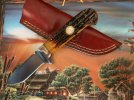Perhaps it can be heat treated for smaller carbides, but....why?
12c27 is formulated for knives, sounds like a much better choice.
"Sandvik 19C27 is Sandviks most wear resistant grade and its developed for abrasive applications. Sandvik 19C27 is the odd grade in the Sandvik knife steel palette because its a coarse carbide grade, unlike Sandvik 7C27Mo2, Sandvik 12C27M, Sandvik 12C27 and Sandvik 13C26.
The coarse carbide grades excel at wear resistance but they dont allow keen edge angles and have limited edge stability, due to the sacrifice of toughness related to the coarse microstructure.
Sandvik 19C27 is developed for industrial blades for cutting cardboard and tough fiber materials. The world class wear resistance is the main reason why this grade should be selected. Sandvik 19C27 is limited in corrosion resistance and we recommend surface coating on Sandvik 19C27 for knife applications in order to avoid corrsion issues.
With a recommended hardness range of 55-63 HRC, excellent wear resistance and a coarse carbide structure Sandvik 19C27 is suitable for industrial blades for cutting tough or/and abrasive materials."
You do realize this thread is three years old.
Big Mike

